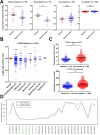LIMD1 is a survival prognostic marker of gastric cancer and hinders tumor progression by suppressing activation of YAP1
- PMID: 30349368
- PMCID: PMC6188213
- DOI: 10.2147/CMAR.S174856
LIMD1 is a survival prognostic marker of gastric cancer and hinders tumor progression by suppressing activation of YAP1
Abstract
Purpose: The purpose of this study was to investigate the clinical significance of LIMD1 and its biological roles in gastric cancer (GC).
Materials and methods: The prognostic value of LIMD1 in GC patients was determined by the online tool Kaplan-Meier Plotter. The biological functions of LIMD1 in GC were examined by in vitro assays, including proliferation, anchorage-independent growth, migration, invasion, and epithelial to mesenchymal transition (EMT) assays. The levels of downstream YAP1 regulated by LIMD1 were measured by Western blot analysis, and the sub-localization of YAP1 in GC cells was visualized by immunofluorescence staining. Differential expression levels and copy number levels of LIMD1 between GC and normal tissues were compared using the Oncomine database. A correlation of LIMD1 mRNA level and the copy number level was depicted by cBioPortal. We also evaluated the methylation status around the LIMD1 genes by Wanderer.
Results: The expression level of LIMD1 positively correlated with the prognosis of GC patients regardless of tumor stage, size, lymph node, metastasis, Lauren's classification, differentiation, gender, treatment, and ERBB2 amplification status. Overexpression of LIMD1 impeded the tumor growth, cell motility, invasiveness, and metastasis, and knockdown of LIMD1 promoted these phenotypes in GC cells. Mechanistically, YAP1 was one of the downstream effectors of LIMD1; LIMD1 suppressed the expression of YAP1 as well as its intracellular translocation. Furthermore, we found that LIMD1 expression was reduced in some of the GC profiling datasets. Gene deletion, instead of DNA methylation, contributed to the reduced expression of LIMD1 in GC.
Conclusion: Our results identified LIMD1 as a convincing prognostic marker as well as a potentially therapeutic target for GC.
Keywords: LIMD1; YAP1; gastric cancer; oncosuppressor; prognostic marker.
Conflict of interest statement
Disclosure The authors report no conflicts of interest in this work.
Figures





Similar articles
-
The transcription factor RUNX2 fuels YAP1 signaling and gastric cancer tumorigenesis.Cancer Sci. 2021 Sep;112(9):3533-3544. doi: 10.1111/cas.15045. Epub 2021 Jul 16. Cancer Sci. 2021. PMID: 34160112 Free PMC article.
-
CircRNA_100876 Is Upregulated in Gastric Cancer (GC) and Promotes the GC Cells' Growth, Migration and Invasion via miR-665/YAP1 Signaling.Front Genet. 2020 Nov 11;11:546275. doi: 10.3389/fgene.2020.546275. eCollection 2020. Front Genet. 2020. PMID: 33262782 Free PMC article.
-
YAP1 enhances cell proliferation, migration, and invasion of gastric cancer in vitro and in vivo.Oncotarget. 2016 Dec 6;7(49):81062-81076. doi: 10.18632/oncotarget.13188. Oncotarget. 2016. PMID: 27835600 Free PMC article.
-
miR-375 is involved in Hippo pathway by targeting YAP1/TEAD4-CTGF axis in gastric carcinogenesis.Cell Death Dis. 2018 Jan 24;9(2):92. doi: 10.1038/s41419-017-0134-0. Cell Death Dis. 2018. PMID: 29367737 Free PMC article.
-
MTMR2 promotes invasion and metastasis of gastric cancer via inactivating IFNγ/STAT1 signaling.J Exp Clin Cancer Res. 2019 May 21;38(1):206. doi: 10.1186/s13046-019-1186-z. J Exp Clin Cancer Res. 2019. PMID: 31113461 Free PMC article.
Cited by
-
Algorithm-Based Meta-Analysis Reveals the Mechanistic Interaction of the Tumor Suppressor LIMD1 With Non-Small-Cell Lung Carcinoma.Front Oncol. 2021 Mar 31;11:632638. doi: 10.3389/fonc.2021.632638. eCollection 2021. Front Oncol. 2021. PMID: 33869018 Free PMC article.
-
Upregulated LIMD1 alleviates pressure overload-induced cardiac hypertrophy via inhibits YAP1/AKT/GSK3β signaling.PLoS One. 2025 Feb 12;20(2):e0316149. doi: 10.1371/journal.pone.0316149. eCollection 2025. PLoS One. 2025. PMID: 39937832 Free PMC article.
-
LIMD1 Increases the Sensitivity of Lung Adenocarcinoma Cells to Cisplatin via the GADD45α/p38 MAPK Signaling Pathway.Front Oncol. 2020 Jul 10;10:969. doi: 10.3389/fonc.2020.00969. eCollection 2020. Front Oncol. 2020. PMID: 32754438 Free PMC article.
-
N6-methyladenosine-dependent pri-miR-17-92 maturation suppresses PTEN/TMEM127 and promotes sensitivity to everolimus in gastric cancer.Cell Death Dis. 2020 Oct 9;11(10):836. doi: 10.1038/s41419-020-03049-w. Cell Death Dis. 2020. PMID: 33037176 Free PMC article.
-
PLOD3 regulates the expression of YAP1 to affect the progression of non-small cell lung cancer via the PKCδ/CDK1/LIMD1 signaling pathway.Lab Invest. 2022 Apr;102(4):440-451. doi: 10.1038/s41374-021-00674-7. Epub 2022 Jan 17. Lab Invest. 2022. PMID: 35039611
References
-
- Ferlay J, Soerjomataram I, Dikshit R, et al. Cancer incidence and mortality worldwide: sources, methods and major patterns in GLOBOCAN 2012. Int J Cancer. 2015;136(5):E359–E386. - PubMed
-
- Fitzmaurice C, Allen C, et al. Global Burden of Disease Cancer Collaboration et al. Global, Regional, and National Cancer Incidence, Mortality, Years of Life Lost, Years Lived With Disability, and Disability-Adjusted Life-years for 32 Cancer Groups, 1990 to 2015: A Systematic Analysis for the Global Burden of Disease Study. JAMA Oncol. 2017;3(4):524–548. - PMC - PubMed
-
- van Cutsem E, Sagaert X, Topal B, Haustermans K, Prenen H. Gastric cancer. Lancet. 2016;388(10060):2654–2664. - PubMed
-
- Kong F, Qi Y, Liu H, et al. Surgery combined with chemotherapy for recurrent gastric cancer achieves better long-term prognosis. Clin Transl Oncol. 2015;17(11):917–924. - PubMed
LinkOut - more resources
Full Text Sources
Research Materials
Miscellaneous

